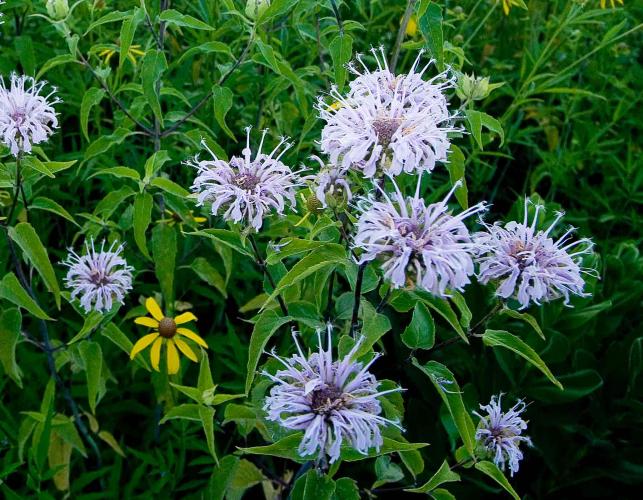
Wild bergamot (also called beebalm and horsemint) is a much-branched, clump-forming perennial, pleasantly scented, with square stems. Flowers normally in 1 terminal cluster, subtended by many small leaves, which frequently are rose-purple. Floral tubes to 1½ inches long, ending in 2 lips, the lower broad and recurving, the upper arching upward with stamens protruding, lavender, lilac, or rose. The subtending bracts are pale green or lilac-tinged. Blooms May–August. Leaves opposite, on definitive stalks, gray-green, with fine hairs, ovate-lanceolate, with small teeth.
Similar species: Beebalm (M. bradburiana) is quite similar, but its leaves are stemless.
Height: to about 3 feet.

Statewide.
Habitat and Conservation
Occurs in fields, prairies, borders of woods and glades, and roadsides. It is also sometimes cultivated in native plant gardens, where it appreciates good air circulation and rather dry or well-drained conditions, which help prevent powdery mildew.
Status
The name wild bergamot refers to the scent of the plant and its use as a culinary and medicinal herb. The fragrance of wild bergamot and its relatives in the genus Monarda is similar to the scent of the bergamot orange, which is grown mostly in Italy and harvested only for its oil. That citrus fruit is most familiar to us as the distinctive flavor of Earl Grey tea and as an ingredient in fine perfumes. Many people think that our wild bergamot (in the mint family) smells more like oregano.
Human Connections
As with the other mints in this genus, this plant is cultivated to use as herbal tea, which has been valued for its medicinal qualities.
It is also cultivated as a showy native plant that attracts butterflies and hummingbirds. It and other horsemints make nice dried flowers.
In additional to its use in herbal tea, wild bergamot can be used, fresh or dried, as a culinary herb, about like you'd use oregano or thyme. Examples include using it in tomato or pizza sauces, in bread dough, fresh leaves included in salads, dried or fresh in vinaigrette dressings, chimichurri sauces, or marinades, as a seasoning in sausage, and so on.
Ecosystem Connections
Many types of insects, including bees, wasps, moths, and butterflies, visit the flowers to drink nectar. Some caterpillars eat the foliage. Herbivorous mammals tend to avoid it, however, as the chemicals in the leaves seem to cause indigestion.




































